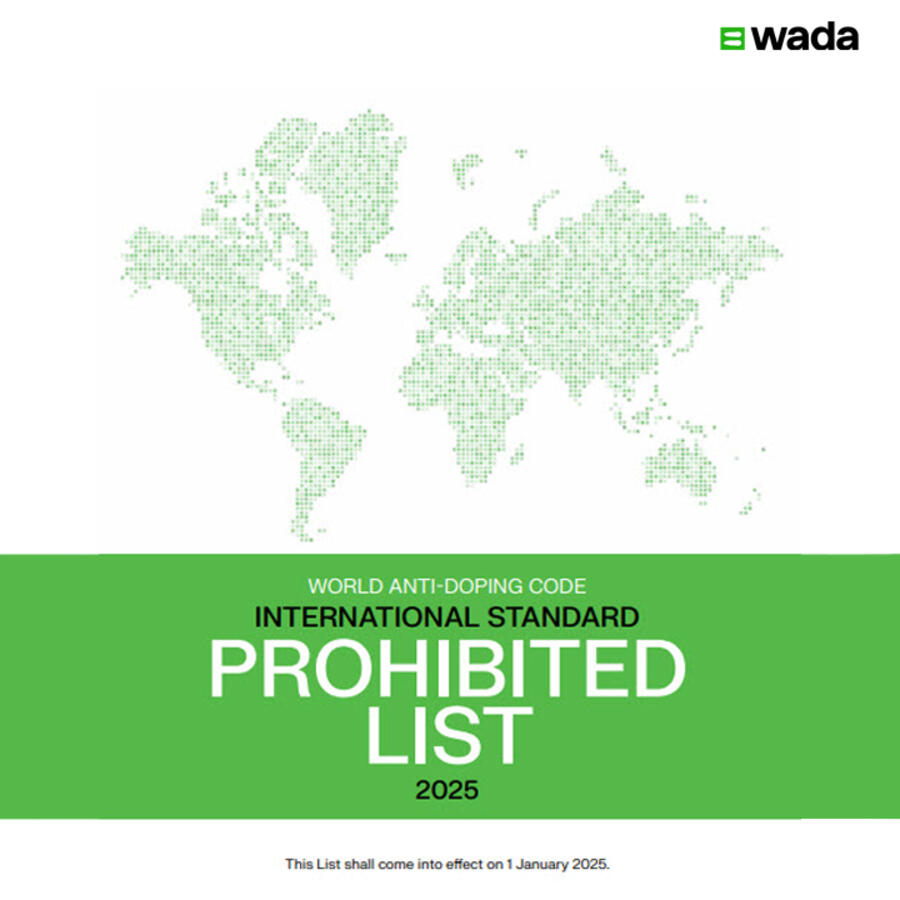Releases
WADA publishes 2025 Prohibited List

Today, the World Anti-Doping Agency (WADA) publishes the 2025 List of Prohibited Substances and Methods (List), which was approved by WADA’s Executive Committee (ExCo) during its meeting on 12 September 2024 and enters into force on 1 January 2025.
We also publish:
- the 2025 Summary of Major Modifications and Explanatory Notes as compared to the 2024 List; and
- the 2025 Monitoring Program, which includes substances that are not on the List, but that WADA wishes to monitor in order to detect potential patterns of misuse in sport.
The List is one of the eight International Standards that are mandatory for all Signatories of the World Anti-Doping Code (Code). It designates which substances and methods are prohibited both in- and out-of-competition and which substances are banned in particular sports.
WADA Director General Olivier Niggli said: “We encourage athletes, their entourage and all stakeholders to acquaint themselves with the Summary of Major Modifications to avoid inadvertent use of substances and methods that are prohibited in sport for 2025. In particular, we kindly ask all Anti-Doping Organizations around the world to share the List and its related documents with athletes, their entourage, and other relevant stakeholders under their jurisdiction.
Major modifications for 2025
As outlined in the 2025 Summary of Major Modifications and Explanatory Notes, the major modifications for 2025 include the following:
- Further examples were added to the following substance classes to help athletes and their entourage better identify prohibited substances:
- S0. Non-approved substances,
- S4. Hormone and metabolic modulators,
- S5. Diuretics and masking agents, and
- S6. Stimulants.
- The dosing intervals of formoterol have been changed, though the maximum daily delivered dose remains the same.
- Donation of blood and blood components including by apheresis are no longer prohibited if performed in an accredited collection center.
- Hydrafinil is now classified as a non-specified stimulant.
- It is clarified that guanfacine is not a prohibited substance.
- Beta-blockers are no longer prohibited in any skiing and snowboarding disciplines.
Annual list review process
WADA leads an annual revision process concerning the List, beginning with an initial meeting in January and concluding with the publication of the List by 1 October. This is an extensive consultation process that includes WADA’s List Expert Advisory Group gathering information including the latest scientific and medical research, trends, and intelligence gathered from law enforcement and pharmaceutical companies; circulating a draft List among stakeholders; and, taking their submissions into consideration to revise the draft, followed by review by the Agency’s Health, Medical and Research (HMR) Committee. The HMR Committee then makes its recommendations to WADA’s ExCo, which approves the List during its September meeting.
For a substance or method to be added to the List, it must be determined that it meets at least two of the following three criteria:
- It has the potential to enhance or enhances sport performance
- It represents an actual or potential health risk to the athletes
- It violates the spirit of sport
The List is released three months ahead of it taking effect so that athletes, their entourage, and other stakeholders can acquaint themselves with any modifications. Ultimately, athletes are responsible for prohibited substances found in their body and prohibited methods found to have been used. Members of an athlete’s entourage are also liable for Anti-Doping Rule Violations if determined to be complicit. Consequently, if there is any doubt as to the status of a substance or method, it is important that they contact their respective Anti-Doping Organizations (International Federation or National Anti-Doping Organization) for advice.
The Therapeutic Use Exemption Program
It should be noted that athletes who have a legitimate medical reason for using a prohibited substance or method that is on the List can apply for a Therapeutic Use Exemption (TUE) to determine whether they meet the criteria outlined in the International Standard for Therapeutic Use Exemptions (ISTUE). The TUE Program is a rigorous and necessary part of elite sport and has overwhelming acceptance from athletes, physicians, and anti-doping stakeholders.
Educational resources
In addition to the documents linked above, WADA has provided, or will provide, educational resources as part of its Code Implementation Support Program (CISP), which can be accessed on the Agency’s Anti-Doping Education and Learning Platform (ADEL). These resources include:
-
A CISP Checklist – Implementing Revised List (available now)
-
Athlete and ASP Guide to the 2025 List (to be available mid-December)
Languages and formats
The 2025 Prohibited List, the 2025 Summary of Modifications and Explanatory Notes, and the 2025 Monitoring Program are available for download on WADA’s website in English and French, with Spanish to follow in the coming weeks.
Stakeholders wishing to translate the List into other languages are kindly asked to signal their interest to code@wada-ama.org. WADA will then provide the necessary files and, once the translation is finalized, will make the translated List available on the Agency’s website.
The List’s mobile-friendly digital edition will go live on 1 January 2025.

